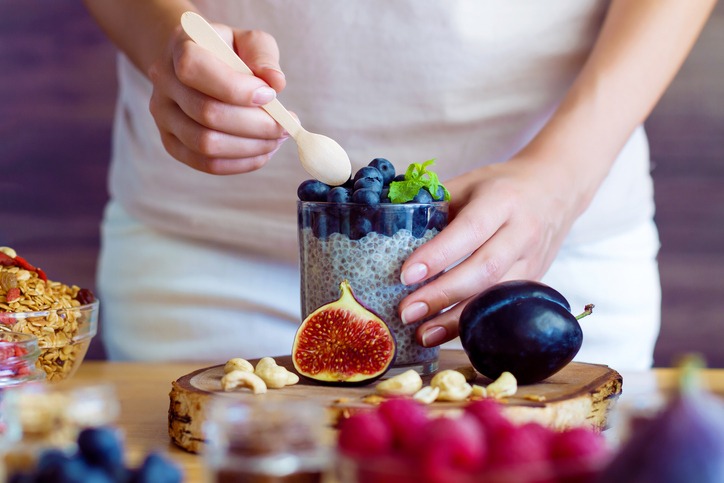CHECK OUT OUR MEDIA MENTION IN DAIRY FOODS
April-2025
More consumers are proactively looking for high-fiber products to benefit from digestive health, prolonged satiety, and blood sugar management, BENEO states.
Research continues to show the importance of prebiotics, probiotics and postbiotics.
One would think that fibers related to promoting health and wellness, specifically digestive health and immune health, would be growing nicely today. That assumption would be correct. Prebiotics, probiotics and postbiotics are all enjoying growth in their respective markets.
“Prebiotics are non-digestible food components that stimulate the growth or activity of beneficial bacteria in the gut. They are essentially food for probiotics. Prebiotics can help reduce inflammation in the gut, which is important for preventing conditions like irritable bowel syndrome and inflammatory bowel disease. Inulin, resistant starch. Fructooligosaccharides (FOS) and Galactooligosaccharides(GOS) are main categories of prebiotic ingredients,” says Jennifer Adams, director of Ingredient Technology & Applications, Fenton, Mo.-based IFPC. “Probiotics are live microorganisms that, when consumed in adequate amounts, provide health benefits, especially for the digestive system,” Adams continues. “Lactobacillus in yogurt is one of the most familiar examples. [And] postbiotics are the byproducts produced by probiotics during fermentation. They include metabolites, enzymes, peptides, and other substances released by live bacteria that exert beneficial effects on health.”
The prebiotics markets is predicted to grow at a compound annual growth rate (CAGR) of 11.3% and reach $13.2 billion in 2029, according to ResearchandMarkets.
The probiotics market size is estimated to be $84.8 billion this year, and is expected to reach $121.9 billion by 2030, at a CAGR of 7.5% during the forecast period of 2025 to 2030, according to Mordor Intelligence.
“The increasing consumer awareness regarding gut health and its connection to overall wellness is driving significant demand for probiotic products available in the market,” the research firm states. “…Probiotics have evolved beyond basic digestive health supplements, with scientific studies revealing their benefits in reducing necrotizing enterocolitis in preterm infants, reducing the occurrence of atopic issues such as eczema in infants, alleviating colic symptoms in breastfed babies, and decreasing the risk or duration of upper respiratory tract infections or gut infections.”
Meanwhile, the global postbiotic market, which the International Scientific Association for Probiotics and Prebiotics calls the “next frontier in gut health solutions,” is expected to reach $3 billion by 2031, growing at an annual CAGR of 6.8%, per Allied Market Research data.
Experts whom Dairy Foods contacted are definitely seeing growth in all ’biotics segments. “Research indicates that more than 95% of consumers fail to meet the recommended daily fiber intake. However, they recognize fiber’s importance in achieving their wellness goals and actively seek it to support digestive health, weight management and satiety. This gap presents a major opportunity for food and beverage brands to develop products that help consumers meet their daily fiber intake goals,” says Vaughn DuBow, senior director, Product Portfolio Marketing, Health and Wellness at Chicago-based ADM.
Functional yogurts, fermented dairy drinks and fiber-fortified frozen desserts are gaining traction as convenient ways to increase fiber intake, he continues. “Fibersol can support dairy brands in fortifying new introductions with fiber, while elevating the sensory experience for greater adherence. Fibersol has high solubility, low viscosity and clarity, as well as heat-, acid-, shear-, freeze- and thaw-stability, ensuring high-fiber frozen novelties and dairy beverages deliver on a consumer-preferred creamy texture.”
Consumer interest in ‘biotics products is soaring, with 76% of consumers recognizing the link between good gut health and overall wellness, reveals COMET.
Hannah Ackermann, RD, vice president of Marketing & Nutrition Affairs, Schaumberg, Ill.-based COMET, adds: “Consumer interest in ’biotics products is soaring, with 76% of consumers recognizing the link between good gut health and overall wellness, further solidifying that this functional food movement is here to stay,” she says, citing the 2023 DSM Global Health Concerns Study.
The GLP-1 trend has changed the ’biotics industry, adds Kyle Krause, BENEO regional product manager, Functional Fibers and Carbohydrates, North America, Parsippany, N.J. “The industry focus is now on delivering nutrient-dense formulations that provide necessary nutrients missing from reduced portion sizes and the suppressed appetites of those taking GLP-1 drugs,” he says. “BENEO also recognizes that more and more consumers are proactively looking for high-fiber products to benefit from digestive health, prolonged satiety, and blood sugar management.” Krause adds that the company’s prebiotic chicory root fibers (Orafti Inulin and Oligofructose) are great tools in the fight against major health problems such as obesity.
Focus on fermentation technology to develop new ingredients could open the door for more functional options for ‘biotic ingredients, states IFPC.
Great for the gut
As research continues to advance, benefits of ’biotics for gut health continue to come into focus. More attention is also being placed on the topic as consumers begin to understand the link between ’biotics and overall health, which goes beyond gut health.
“Microbiome health is most associated with the gut, but consumers are discovering how ’biotics can support other living ’biomes’ within the body including oral, skin and vaginal, and new product innovation is catching on,” explains Ackermann, who adds that in November, Givaudan became an authorized distributor of COMET’s natural, gut-friendly prebiotic fiber, Arrabina. “It is a sustainable fiber that is Upcycled Certified and has a low carbon footprint,” she states.
The gut microbiome influences a person’s digestive health — and overall health — “as it interacts heavily with other organs in the human body like the brain, liver, kidneys and muscles,” Krause notes. “Therefore, nutrition that is beneficial to the gut and its microbiome is key to a person’s long-term health.”
The BENEO executive also cites scientific research, which has established other benefits provided by chicory root fibers related to blood sugar management, immune health weight management and calcium absorption for bone health. “A new systematic literature review with meta-analyses, conducted by Reimer et al, demonstrates the relevance of chicory root fibers in the context of weight management. It could be demonstrated that chicory root fiber intake promotes a significant reduction in body weight, body mass index, fat mass, waist circumference, and, to a certain extent, body fat percentage,” Krause says.
According to DuBow, an emerging area of research is the gut-brain axis, which explores how gut microbiota influence cognitive and emotional health. “We’re currently seeing a particular need for solutions assisting with stress, mood and sleep. The newest addition to our health and wellness portfolio, Lactobacillus gasseri CP2305 postbiotic, addresses demand for stress management, mood support and sleep quality,” he states. “Studies show that L. gasseri CP2305 may support emotional well-being, reduce stress, better sleep efficiency, reduce time to fall asleep/sleep latency, healthy overall sleep quality and improve total sleep duration.”
Research reveals that in the United States, 73% of consumers are looking to improve their sleep, and 75% of U.S. consumers are interested in improving their cognitive health because they want a good quality of life, the ADM senior director notes. “Brands that leverage solutions with clinically documented evidence targeting cognitive and emotional well-being will find continued success with consumers seeking support from functional food.”
BENEO believes that demand for synbiotics (combinations of pro- and prebiotics) will increase.
The future of ‘biotics
With a rising understanding of the benefits of the different ’biotics, BENEO believes that demand for synbiotics (a combinations of pro- and prebiotics) will increase. “In line with more personalized nutrition, the field of precision prebiotics is also interesting. Here, we are talking about specific prebiotic fibers that selectively feed groups of gut microbes established to be important components of a healthy gut,” Krause relays.
ADM believes the future of gut health is rooted in postbiotics. “Due to their resiliency, postbiotics are leading the way for new product development in dairy- and plant-based dairy applications, which serve as accessible formats for consumers to incorporate next-generation gut health solutions into daily routines,” DuBow notes.
With growing consumer recognition of the microbiome’s role in overall health, ADM expects to see increased innovation in gut-supporting dairy, plant-based, and functional food products that “go beyond digestion to address aspects of cognitive well-being, skin health, women’s health and whole-body health. Personalization, multifunctionality, and stability will be key drivers in the evolution of biotic formulations,” DuBow predicts. “Consumers seek products tailored to their individual health concerns, which is fueling demand for multi-strain probiotic blends and formulations that combine pre-, pro- and postbiotics for targeted benefits.”
The space is wide open for other ’biotic foods and drinks to appeal to consumers’ interest in mechanisms other than GLP-1 drugs that regulate appetite in the brain and improve insulin responses and satiety, with prebiotic fibers in an “ideal position to leverage this opportunity,” prognosticates COMET’s Ackermann.
However, she cautions that not all fiber is equal or can provide satiety or GLP-1 benefits. “To boost satiation hormones, you need to eat fiber that bacteria can digest, i.e., fermentable prebiotic fibers, such as beta-glucan, arabinoxylan and oligosaccharides,” she stresses. “Insoluble fiber, such as the psyllium husks in Metamucil, is important to good digestive health but for regularity, not satiation. While soluble fiber can slow digestive transit time, insoluble fiber can speed it up.”
Researchers recently found that prebiotic fiber shakes improved metabolic health, digestion, and health-related quality-of-life scores like sleep, mood and energy levels, the COMET executive continues. “With that, it is fair to say that clinically proven prebiotic products have the potential to provide a more natural and sustainable solution to promote metabolic health and weight management.”
IFPC’s Adams cites fermentation technology as a key to developing new ingredients that could “open the door for more functional options for ’biotic ingredients. Specifically, increased stability and efficiency of production would expand the potential food formats.”
Adams concludes: “Stable probiotics open up the possibility of incorporating them into a wider variety of food formats, including those that were previously difficult to stabilize (e.g., heat-processed foods or shelf-stable items). Efficient production would lower the cost barrier for incorporation. Further, the potential for customized ’biotic ingredients that target specific health benefits or functions could be possible with advances in production technologies.” DF






